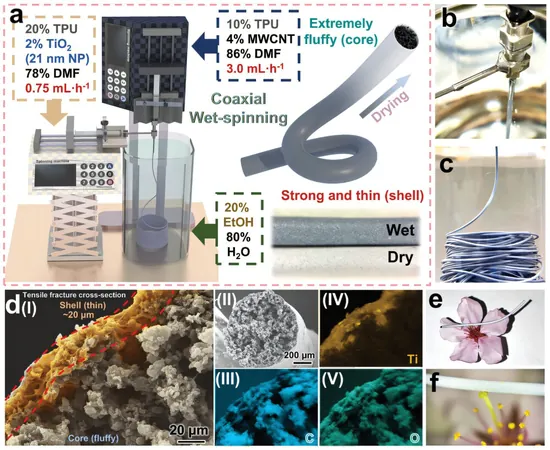
Revolutionary DNA-inspired Fiber Sensor Set to Transform Wearable Technology
2025-04-28
Author: Wei
A Breakthrough in Wearable Sensors!
Researchers at Shinshu University have unveiled a groundbreaking fiber sensor that takes inspiration from the iconic structure of DNA. This innovative design promises to enhance the durability and flexibility of sensors used in wearable technology, potentially revolutionizing how we interact with smart devices.
The Limitations of Traditional Sensors
Traditional fiber sensors usually feature electrodes at both ends, making them prone to damage when subjected to the repeated movements typical around body joints. This often leads to unreliable measurements and sensor failure, particularly in high-movement areas like fingers or knees.
A DNA-Inspired Solution!
Enter the double-helical design! By placing both electrodes on one end of the fiber, this new sensor significantly reduces strain during motion, addressing a significant flaw in conventional designs. This advancement not only boosts durability but also ensures a more reliable connection.
Designed for Everyday Use
These flexible fiber sensors, owing to their lightweight and compact nature, are perfectly suited for daily wearables. However, previous technologies struggled with mechanical challenges. Thanks to this new double-helical architecture, wearables can more comfortably and effectively adapt to various body movements.
Technical Precision in Structure
The genius behind this innovation lies in mimicking DNA's robust structure. The researchers combined two coaxial fibers, creating a stable, twisted double helix. Each fiber utilizes a coaxial wet-spinning method, featuring an insulating outer layer and a conductive inner core enriched with multi-walled carbon nanotubes.
Simplifying Connectivity
After the fibers undergo heat treatment, they naturally twist into a double helix with electrodes on one end, eliminating the chaotic wiring often found in traditional designs. "Our TT/MT dual-helical fiber simplifies sensor wiring, making it a game-changer in flexible sensor technology," noted co-author Mr. Ziwei Chen.
Small but Mighty
Measuring less than 1 mm in diameter, the slender TT/MT dual-helical fiber sensor integrates seamlessly into wearable textiles. It’s rigorously tested, standing up to over 1,000 stretching cycles and extending more than 300% beyond its original length without a hitch.
Wide-Ranging Applications
Thanks to its innovative design, this sensor can be affixed on low-movement areas, facilitating applications from tracking finger gestures to monitoring facial expressions and even detecting breathing patterns during sleep. In tests, a glove equipped with this sensor recognized six hand gestures with an impressive 98.8% accuracy!
Empowering Users and Expanding Possibilities
The potential of this technology extends to aiding individuals with disabilities and enhancing Bluetooth-connected wearables for real-time monitoring in rehabilitation and sports training. Future applications might include embedding these sensors into clothing for high-risk activities—sending alerts in emergencies or health crises.
A Vision for the Future
With this groundbreaking design, researchers aspire to pave the way for the next generation of intelligent fibers—durable, sensitive, and easily integrated into everyday apparel. As Dr. Zhu passionately stated, "Our approach could inspire diverse intelligent fibers tailored for numerous applications, potentially redefining wearable technology as we know it."

 Brasil (PT)
Brasil (PT)
 Canada (EN)
Canada (EN)
 Chile (ES)
Chile (ES)
 Česko (CS)
Česko (CS)
 대한민국 (KO)
대한민국 (KO)
 España (ES)
España (ES)
 France (FR)
France (FR)
 Hong Kong (EN)
Hong Kong (EN)
 Italia (IT)
Italia (IT)
 日本 (JA)
日本 (JA)
 Magyarország (HU)
Magyarország (HU)
 Norge (NO)
Norge (NO)
 Polska (PL)
Polska (PL)
 Schweiz (DE)
Schweiz (DE)
 Singapore (EN)
Singapore (EN)
 Sverige (SV)
Sverige (SV)
 Suomi (FI)
Suomi (FI)
 Türkiye (TR)
Türkiye (TR)
 الإمارات العربية المتحدة (AR)
الإمارات العربية المتحدة (AR)